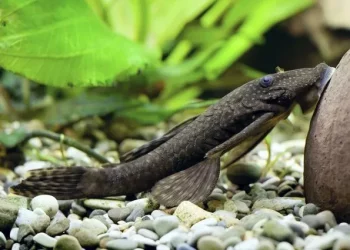The Australian lungfish, also known as the Queensland lungfish, is an ancient freshwater fish species that can be found only in the rivers and creeks of Queensland, Australia. It is one of the few remaining species of lungfish, which have been around for over 380 million years, making them one of the oldest living vertebrates on the planet. The Australian lungfish is an important part of the Australian ecosystem, and understanding what they eat is crucial for maintaining the balance of the aquatic environment.
The Australian lungfish is an omnivorous fish species, which means that it eats both plant and animal matter. In the wild, the diet of the Australian lungfish consists of a variety of food sources, including insects, crustaceans, worms, mollusks, fish, and plant matter. This diverse diet allows the lungfish to adapt to changing environmental conditions and ensure its survival in its natural habitat.
One of the primary food sources for the Australian lungfish is insects. The lungfish has a specialized diet that includes insects such as beetles, grasshoppers, and crickets. These insects are typically found on the banks of rivers and creeks and are an important source of protein and nutrients for the lungfish.
Another important food source for the Australian lungfish is crustaceans. The lungfish feeds on a variety of crustaceans, including crayfish and freshwater shrimp. These small creatures are found in the freshwater rivers and creeks of Queensland and are an important source of protein and minerals for the lungfish.
The Australian lungfish also eats worms and mollusks, such as snails and clams. These soft-bodied creatures are found in the sediment at the bottom of rivers and creeks and are an important food source for the lungfish. The lungfish has adapted to feeding on these creatures by using its specialized mouth to suck them up from the sediment.
In addition to animal matter, the Australian lungfish also eats plant matter. The lungfish feeds on a variety of aquatic plants, including water lilies and water hyacinths. These plants provide the lungfish with important nutrients and minerals, and also help to maintain the health of the aquatic environment.
It is important to note that the diet of the Australian lungfish can vary depending on the season and the availability of food sources. During the dry season, for example, when food sources are scarce, the lungfish may rely more heavily on plant matter. During the wet season, when food sources are more abundant, the lungfish may consume more animal matter.
In conclusion, the Australian lungfish is an omnivorous fish species that eats a diverse range of food sources, including insects, crustaceans, worms, mollusks, and plant matter. Understanding the diet of the lungfish is crucial for maintaining the balance of the aquatic environment and ensuring the survival of this ancient and important fish species.


























